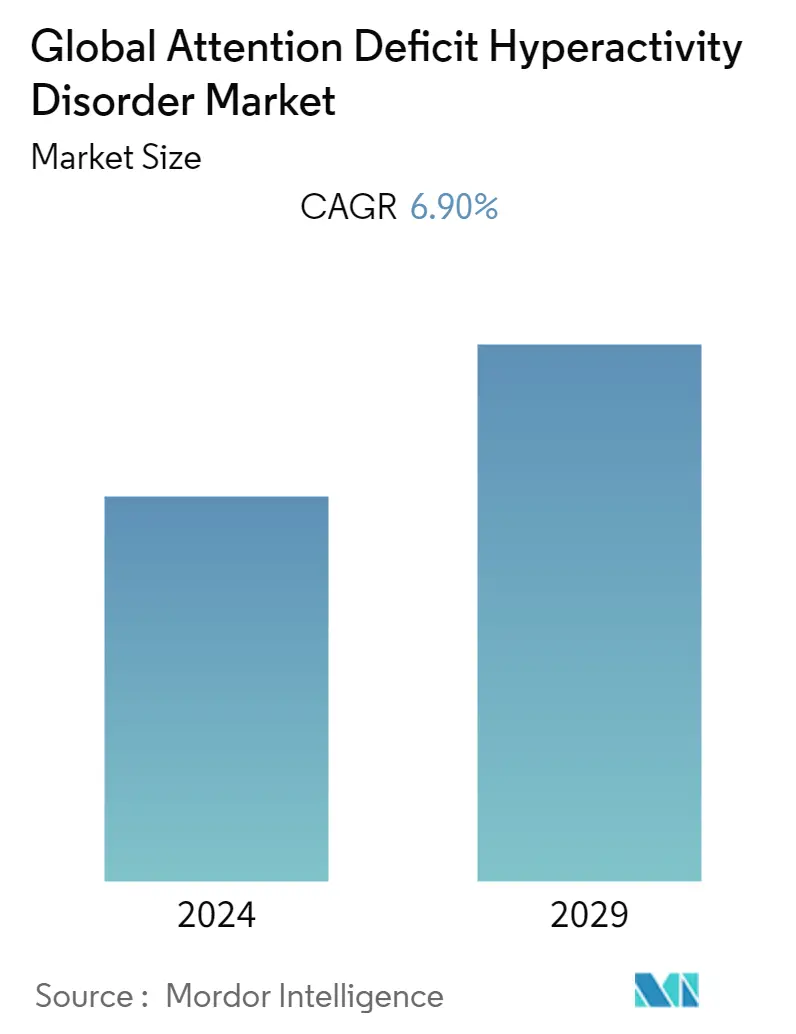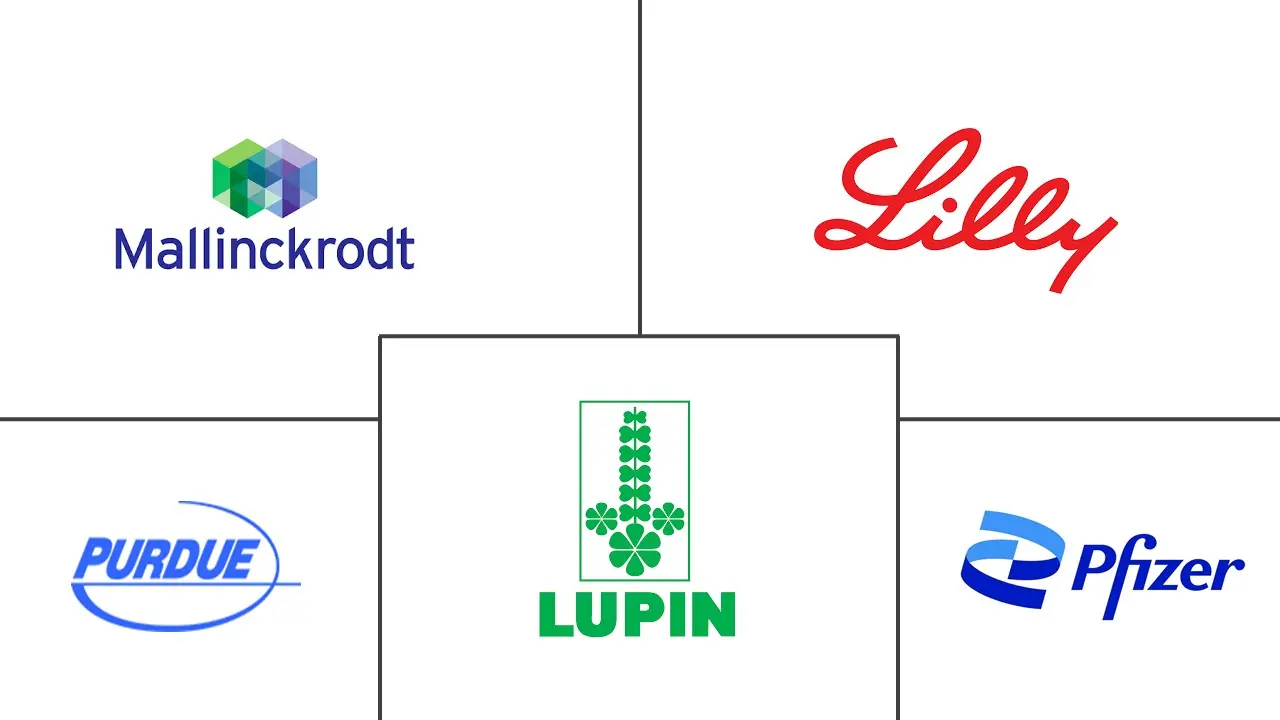Market Size of Global Attention Deficit Hyperactivity Disorder Industry

| Study Period | 2019 - 2029 |
| Base Year For Estimation | 2023 |
| CAGR | 6.90 % |
| Fastest Growing Market | North America |
| Largest Market | Asia-Pacific |
| Market Concentration | Medium |
Major Players
*Disclaimer: Major Players sorted in no particular order |
Attention Deficit Hyperactivity Disorder Market Analysis
The attention deficit hyperactivity disorder market is expected to grow at a registered CAGR of 6.9% during the forecast period (2022-2027).
The attention deficit hyperactivity disorder (ADHD) market is significantly impacted as a result of the COVID-19 pandemic. Governments from various countries are taking steps to combat attention deficit hyperactivity disorder (ADHD) in children. According to the study titled "Behavioral Implications of the Covid-19 Process for Autism Spectrum Disorder, and Individuals' Comprehension of and Reactions to the Pandemic Conditions," published in the Frontier in Psychiatry in November 2020, during the Covid-19 outbreak, symptoms of children with attention deficit hyperactivity disorder (ADHD) worsened significantly. Due to the stress caused by the COVID-19 pandemic, patients with attention deficit hyperactivity disorder (ADHD) have become more vulnerable. Thus, the attention deficit hyperactivity disorder market is significantly impacted by COVID-19.
During the forecast period, the global attention deficit hyperactivity disorder (ADHD) therapeutics market is expected to grow due to an increase in the prevalence of the disorder. For instance, as per a February 2021 published study titled, "The prevalence of adult attention-deficit hyperactivity disorder: A global systematic review and meta-analysis," the prevalence of persistent adult ADHD was 2.58%, and that of symptomatic adult ADHD was 6.76%, translating to 139.84 million and 366.33 million affected adults in 2020 globally. Thus, rising in the burden of ADHD is expected to rise in demand for its treatment anticipated to boost the market over the forecast period.
Furthermore, the growing emphasis on research and development is resulting in the development of effective ADHD treatments, which is contributing to market growth. For instance, according to the study titled "Neurofunctional and behavioral measures associated with fMRI-Neurofeedback learning in adolescents with Attention-Deficit/Hyperactivity Disorder," published in the NeuroImage Clinical in May 2020, a larger trial with 100 children with ADHD was funded by the Medical Research Council for GBP 1.3 million. New collaborations with the National Institute of Mental Health and Dresden University were also formed as a result of the work. Since then, the team has received funding (roughly GBP 2 million from the National Institute for Health Research, Action Medical Research) to test other brain-based therapies in ADHD, including non-invasive brain stimulation treatments like transcranial direct current stimulation and stimulation of the trigeminal nerve, which controls facial sensations. Such a development in a treatment option for ADHD treatment is expected to boost the market over the forecast period.
The ADHD market is expected to grow due to a rise in public awareness about mental health and increased government funding. The rising number of people suffering from a variety of mental health disorders, including attention-deficit/hyperactivity disorder (ADHD), has drawn the attention of governments all over the world, forcing them to take action. As per the Regional Development Australia updates in July 2021, in 2021-22, the New South Wales (NSW) Government has contributed USD 1.8 million in funding for the ADHD pilot program, with a total investment of USD 7.7 million for the trial a new model of care and management for children with behavioral issues including attention-deficit hyperactivity disorder (ADHD) in regional NSW over four years.
Moreover, during the forecast period, key companies focusing on research and development in the treatment of attention deficit hyperactivity disorder (ADHD) therapeutics are expected to drive the global attention deficit hyperactivity disorder (ADHD) therapeutics market. For instance, in June 2020, Otsuka Pharmaceutical Co., Ltd. and Otsuka Pharmaceutical Development & Commercialization, Inc., a subsidiary in the United States, reported positive top-line results from phase 3 clinical trials evaluating the efficacy, safety, and tolerability of oral centanafadine, a novel investigational compound for the treatment of adult patients with attention deficit hyperactivity disorder.
Thus, the aforementioned factors are likely to drive the growth of the market during the forecast period. However, less availability of non-stimulant ADHD drugs and underdiagnosis of ADHD. Thus, these factors act as some of the major restraints to the studied market.
Attention Deficit Hyperactivity Disorder Industry Segmentation
As per the scope of the report, Attention deficit hyperactivity disorder (ADHD) is one of the most common neurodevelopmental disorders that primarily affects children. ADHD is often diagnosed in childhood and persists into adulthood. Children with ADHD may daydream excessively, forget or lose things, have difficulty resisting temptation, have trouble taking turns, have difficulty getting along with others, be overly active, and have difficulty paying attention. The attention deficit hyperactivity disorder market is segmented by drug type (stimulant, non-stimulant), age (adult (aged 18 and above), children), distribution (retail pharmacy, hospital pharmacy), and geography (North America, Europe, Asia-Pacific, Middle-East and Africa, and South America). The market report also covers the estimated market sizes and trends for 17 different countries across major regions globally. The report offers the value (in USD million) for the above segments.
| By Drug Type | |||||||
| |||||||
|
| By Age | |
| Adult (Aged 18 and above) | |
| Children |
| By Distribution Channel | |
| Retail Pharmacy | |
| Hospital Pharmacy |
| Geography | ||||||||
| ||||||||
| ||||||||
| ||||||||
| ||||||||
|
Global Attention Deficit Hyperactivity Disorder Market Size Summary
The attention deficit hyperactivity disorder (ADHD) market is poised for significant growth, driven by an increasing prevalence of the disorder and heightened public awareness of mental health issues. The COVID-19 pandemic has exacerbated ADHD symptoms, leading to a greater demand for effective treatments. This demand is further fueled by government initiatives and funding aimed at addressing ADHD, as well as ongoing research and development efforts that are yielding new therapeutic options. The market is characterized by a strong focus on stimulant medications, which remain the most effective treatment for ADHD symptoms, and are supported by numerous clinical trials and regulatory approvals. The North American region, in particular, is expected to dominate the market due to its high prescription rates and substantial healthcare spending on ADHD treatments.
The competitive landscape of the ADHD market is moderately intense, with several key players engaging in strategies such as product innovation, mergers, and acquisitions to enhance their market position. Companies like Eli Lilly & Company, Pfizer, and Johnson & Johnson Services LLC are actively expanding their product portfolios and geographic reach. The approval and commercialization of new drugs, such as the orally disintegrating medication Adzenys XR-ODT and the dextroamphetamine transdermal system Xelstrym, are expected to drive market growth. Despite challenges like the limited availability of non-stimulant ADHD drugs and underdiagnosis, the market is anticipated to grow steadily, supported by advancements in treatment options and increased healthcare investments.
Global Attention Deficit Hyperactivity Disorder Market Size - Table of Contents
-
1. MARKET DYNAMICS
-
1.1 Market Overview
-
1.2 Market Drivers
-
1.2.1 Increasing Burden Of ADHD
-
1.2.2 Increasing Awareness Regarding ADHD Among Physicians and Patients
-
-
1.3 Market Restraints
-
1.3.1 Underdiagnosis Of ADHD
-
-
1.4 Porter's Five Force Analysis
-
1.4.1 Threat of New Entrants
-
1.4.2 Bargaining Power of Buyers/Consumers
-
1.4.3 Bargaining Power of Suppliers
-
1.4.4 Threat of Substitute Products
-
1.4.5 Intensity of Competitive Rivalry
-
-
-
2. MARKET SEGMENTATION (Market Size by Value - USD million)
-
2.1 By Drug Type
-
2.1.1 Stimulant
-
2.1.1.1 Amphetamine
-
2.1.1.2 Methylphenidate
-
2.1.1.3 Dextroamphetamine
-
2.1.1.4 Dexmethylphenidate
-
2.1.1.5 Lisdexamfetamine dimesylate
-
-
2.1.2 Non Stimulant
-
2.1.2.1 Atomoxetine
-
2.1.2.2 Bupropion
-
2.1.2.3 Guanfacine
-
2.1.2.4 Clonidine
-
-
-
2.2 By Age
-
2.2.1 Adult (Aged 18 and above)
-
2.2.2 Children
-
-
2.3 By Distribution Channel
-
2.3.1 Retail Pharmacy
-
2.3.2 Hospital Pharmacy
-
-
2.4 Geography
-
2.4.1 North America
-
2.4.1.1 United States
-
2.4.1.2 Canada
-
2.4.1.3 Mexico
-
-
2.4.2 Europe
-
2.4.2.1 Germany
-
2.4.2.2 United Kingdom
-
2.4.2.3 France
-
2.4.2.4 Italy
-
2.4.2.5 Spain
-
2.4.2.6 Rest of Europe
-
-
2.4.3 Asia-Pacific
-
2.4.3.1 China
-
2.4.3.2 Japan
-
2.4.3.3 India
-
2.4.3.4 Australia
-
2.4.3.5 South Korea
-
2.4.3.6 Rest of Asia-Pacific
-
-
2.4.4 Middle-East and Africa
-
2.4.4.1 GCC
-
2.4.4.2 South Africa
-
2.4.4.3 Rest of Middle-East and Africa
-
-
2.4.5 South America
-
2.4.5.1 Brazil
-
2.4.5.2 Argentina
-
2.4.5.3 Rest of South America
-
-
-
Global Attention Deficit Hyperactivity Disorder Market Size FAQs
What is the current Global Attention Deficit Hyperactivity Disorder Market size?
The Global Attention Deficit Hyperactivity Disorder Market is projected to register a CAGR of 6.90% during the forecast period (2024-2029)
Who are the key players in Global Attention Deficit Hyperactivity Disorder Market?
Eli Lily & Company, Pfizer, Lupin, Mallinckrodt and Purdue Pharma L.P are the major companies operating in the Global Attention Deficit Hyperactivity Disorder Market.

